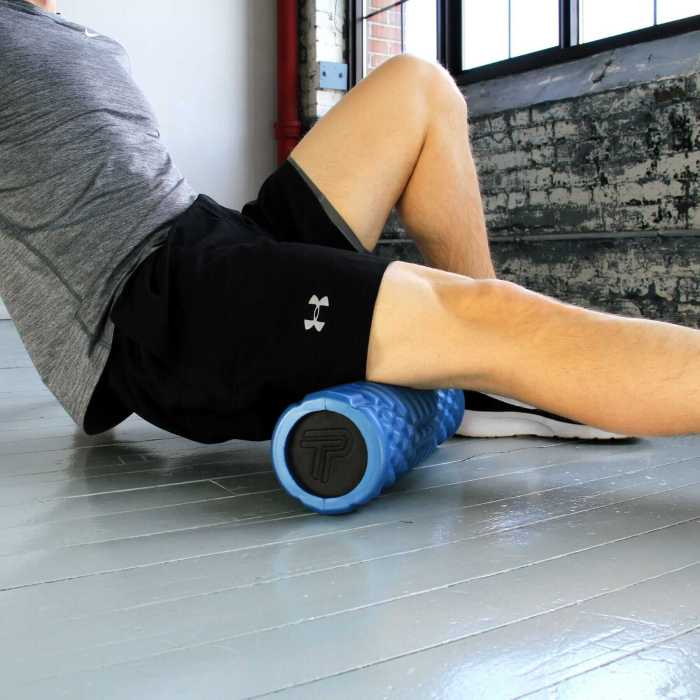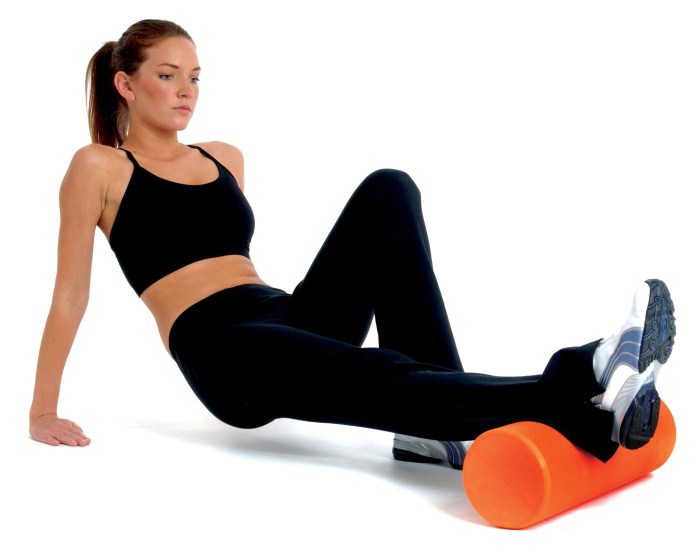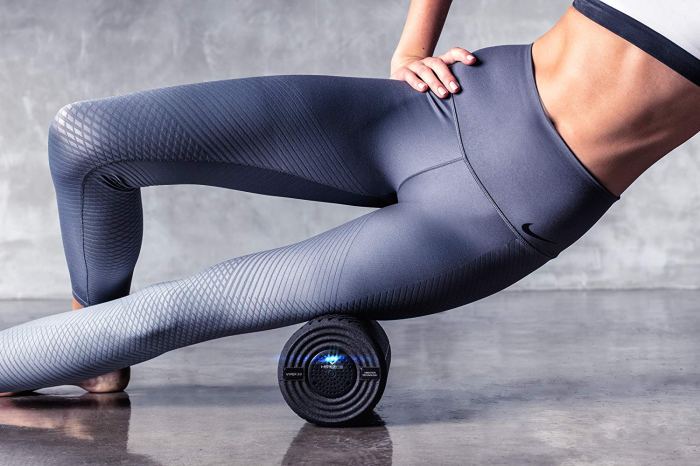Embark on a journey of muscle rejuvenation with the foam roller, an indispensable tool for self-massage and recovery. Delve into its anatomy, techniques, and benefits to unlock the secrets of enhanced flexibility, reduced soreness, and accelerated recovery.
From its humble beginnings as a simple cylindrical device, the foam roller has evolved into a versatile tool with varying shapes, sizes, and textures. Discover the different types available, each designed to cater to specific muscle groups and needs.
Foam Roller Anatomy

A foam roller is a cylindrical-shaped fitness tool used for self-massage and muscle recovery. It typically has a length of 12 to 36 inches and a diameter of 4 to 6 inches. Foam rollers are made from various materials, including foam, rubber, and PVC, providing varying degrees of firmness and texture.
Types of Foam Rollers
There are several types of foam rollers available, each designed for specific purposes:
- Standard Foam Rollers:These are the most common type of foam rollers, made from dense foam and offering a firm massage experience.
- Textured Foam Rollers:These rollers have a textured surface with raised bumps or ridges, providing a more intense massage that can help target trigger points.
- Vibrating Foam Rollers:These rollers incorporate a vibrating mechanism that enhances the massage experience, promoting relaxation and reducing muscle soreness.
Foam Rolling Techniques
Foam rolling involves utilizing a foam roller to apply pressure and massage specific muscle groups. It offers various techniques, each targeting different goals. This guide explores these techniques, including self-massage, trigger point release, and muscle activation, providing insights into proper body positioning, pressure application, and rolling duration for effective results.
Self-Massage
Self-massage with a foam roller involves applying gentle to moderate pressure while rolling over targeted muscle groups. This technique promotes relaxation, reduces muscle tension, and improves blood flow. Begin by positioning the foam roller perpendicular to the muscle you wish to massage.
Apply steady pressure as you roll slowly back and forth, maintaining contact for 30-60 seconds per area.
When seeking a cozy and supportive night’s sleep, consider the innovative ripple mattress . Its unique wave-like design conforms to your body, reducing pressure points and promoting restful slumber.
Trigger Point Release
Trigger point release targets specific, tender areas within muscles known as trigger points. These points can cause pain and discomfort when pressure is applied. To release trigger points, position the foam roller directly over the trigger point and apply firm, sustained pressure for 20-30 seconds.
For those who value both style and comfort, the yeezy foam runner is an excellent choice. These futuristic sneakers feature a lightweight, breathable design that keeps your feet cool and comfortable all day long.
Repeat the process until the pain or discomfort subsides.
Muscle Activation
Muscle activation with a foam roller involves using the roller to stimulate and prepare muscles for activity. This technique enhances blood flow, increases range of motion, and improves muscle performance. Position the foam roller parallel to the muscle you wish to activate.
Apply light to moderate pressure as you roll slowly back and forth, focusing on the entire length of the muscle for 15-30 seconds per area.
Benefits of Foam Rolling: Foam Roller
Foam rolling, a self-myofascial release technique, offers a multitude of physiological and therapeutic benefits, enhancing overall well-being and athletic performance.
Primarily, foam rolling promotes increased flexibility and range of motion. By applying pressure to specific muscle groups, it helps break down adhesions and tight knots, allowing for greater mobility and a wider range of motion.
Reduced Muscle Soreness
Foam rolling is effective in reducing muscle soreness, both post-workout and chronic. It stimulates blood flow to the affected areas, promoting the removal of metabolic waste products such as lactic acid. This enhanced circulation accelerates muscle recovery, reducing stiffness and pain.
Enhanced Recovery
As a result of improved flexibility and reduced soreness, foam rolling enhances overall recovery after physical activity. It promotes muscle relaxation, decreases inflammation, and facilitates the restoration of normal muscle function. This expedites recovery, allowing for faster return to activity.
Injury Prevention and Rehabilitation
Foam rolling plays a crucial role in injury prevention and rehabilitation. By addressing muscle imbalances and tightness, it can help prevent common injuries associated with exercise and daily activities. Additionally, foam rolling assists in the rehabilitation process by promoting tissue repair and reducing scar tissue formation.
Foam Roller Exercises

Incorporating foam roller exercises into your fitness routine can greatly enhance muscle recovery, flexibility, and performance. By applying targeted pressure to specific muscle groups, you can effectively release tension, improve blood circulation, and promote overall well-being.
The following table Artikels a comprehensive range of foam roller exercises designed to target various muscle groups. Each exercise includes clear instructions, recommended repetitions, and modifications to suit different fitness levels.
Upper Body
| Exercise | Target Muscle Group | Instructions | Repetitions | Modifications |
|---|---|---|---|---|
| Chest Roll | Pectorals | Lie on your back with the roller under your upper back. Roll forward until the roller reaches your shoulders, then roll back to the starting position. | 10-15 | Place your feet on a wall or bench to increase intensity. |
| Triceps Roll | Triceps | Lie on your back with the roller under your triceps. Bend your elbows and roll the roller up and down the length of your triceps. | 10-15 | Use a softer roller or place a towel between your skin and the roller for reduced pressure. |
| Shoulder Roll | Shoulders | Stand with your feet shoulder-width apart. Place the roller on the back of your shoulders and roll it up and down, massaging the muscles between your shoulder blades. | 10-15 | Use a smaller roller or a tennis ball for more targeted pressure. |
Lower Body
| Exercise | Target Muscle Group | Instructions | Repetitions | Modifications |
|---|---|---|---|---|
| Quad Roll | Quadriceps | Lie on your stomach with the roller under your quads. Roll forward until the roller reaches your hip crease, then roll back to the starting position. | 10-15 | Place your hands on your hips or on the floor to stabilize yourself. |
| Hamstring Roll | Hamstrings | Lie on your back with the roller under your hamstrings. Bend your knees and roll the roller up and down the length of your hamstrings. | 10-15 | Use a softer roller or place a towel between your skin and the roller for reduced pressure. |
| Calf Roll | Calves | Stand with your feet shoulder-width apart. Place the roller under your calves and roll forward until the roller reaches your Achilles tendon, then roll back to the starting position. | 10-15 | Use a harder roller or a tennis ball for more targeted pressure. |
Foam Roller Safety
Foam rolling is a beneficial practice, but it’s crucial to use it safely to prevent injuries. Consider the following guidelines:
Pre-existing Conditions
- Individuals with certain medical conditions, such as severe osteoporosis, recent surgery, or deep vein thrombosis (DVT), should consult a healthcare professional before using a foam roller.
Proper Technique
Always use a foam roller with proper technique. Avoid applying excessive pressure or over-rolling, which can cause discomfort or injury.
Pain Threshold
Listen to your body and stop rolling if you experience any sharp or severe pain. Foam rolling should be challenging but not painful.
Duration, Foam roller
Start with short rolling sessions (5-10 minutes) and gradually increase the duration as your body adapts.
Hydration
Stay well-hydrated before and after foam rolling, as it can promote blood flow and muscle recovery.
Ultimate Conclusion

In conclusion, the foam roller has emerged as a powerful ally in the pursuit of muscle health and recovery. Its ability to improve flexibility, reduce soreness, and enhance recovery makes it an essential tool for athletes, fitness enthusiasts, and individuals seeking pain relief.
Whether you’re a seasoned pro or just starting your fitness journey, incorporating foam rolling into your routine can unlock a world of benefits. Embrace the power of this versatile tool and experience the transformative effects on your muscles.
General Inquiries
Is foam rolling painful?
Foam rolling can cause some discomfort, especially when targeting tight or sore muscles. However, the pain should be tolerable and should subside as you continue rolling.
How often should I foam roll?
For optimal results, aim to foam roll 2-3 times per week, focusing on different muscle groups each session.
Can foam rolling help prevent injuries?
Yes, foam rolling can help prevent injuries by improving flexibility, reducing muscle tension, and promoting blood flow.